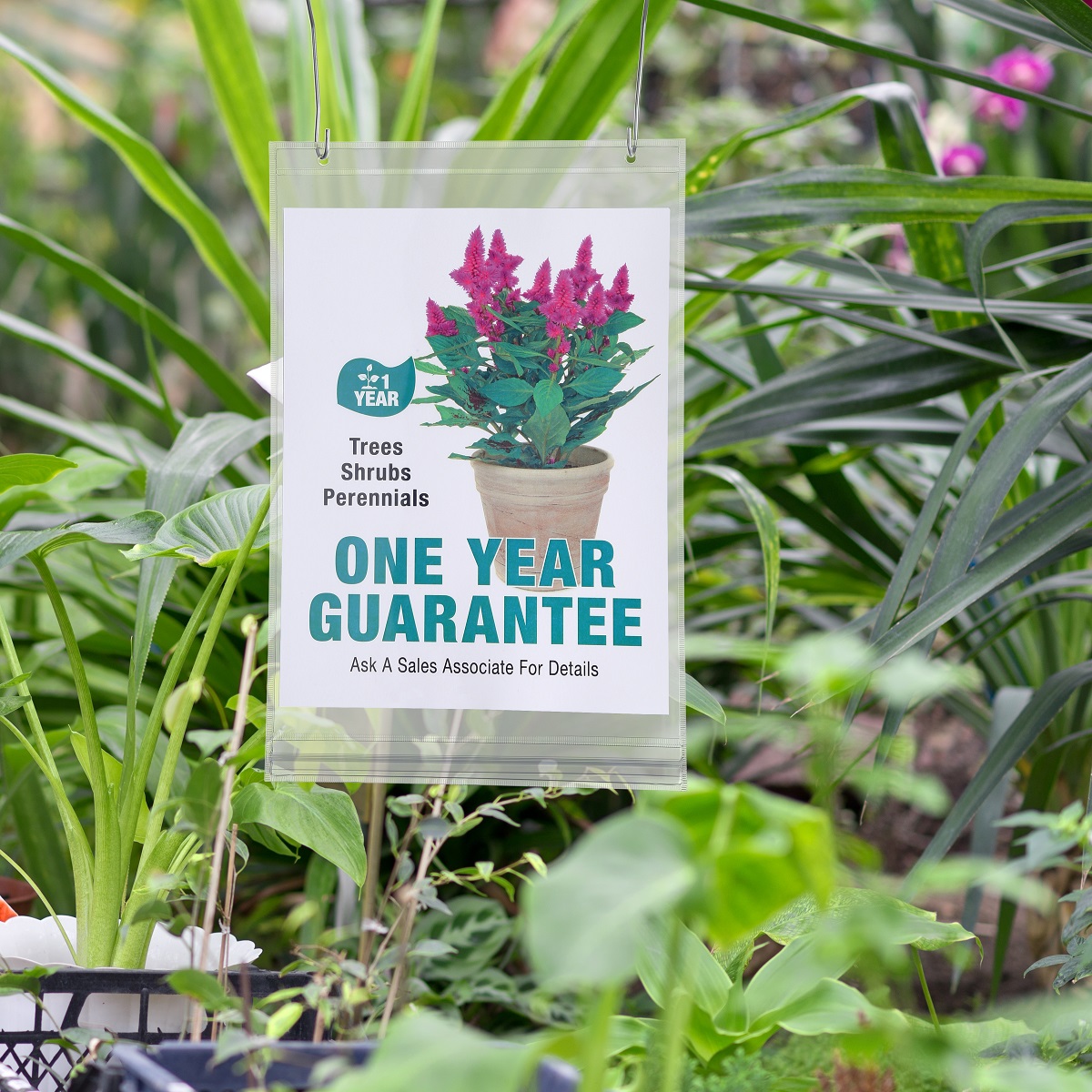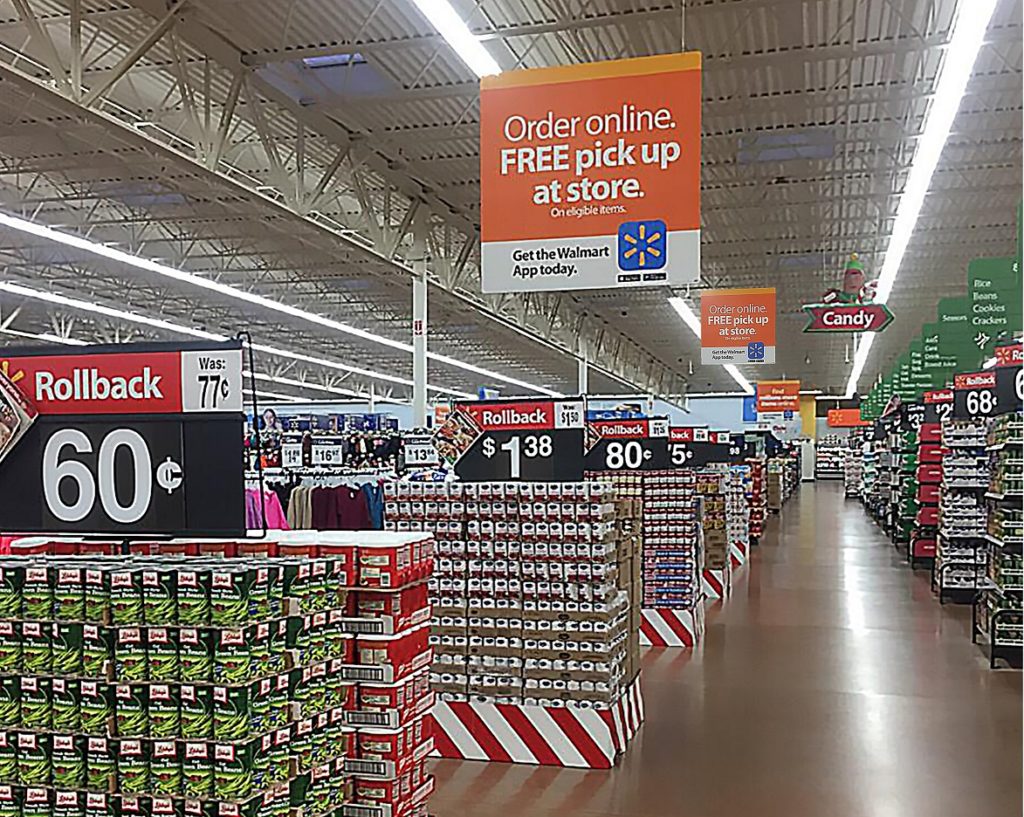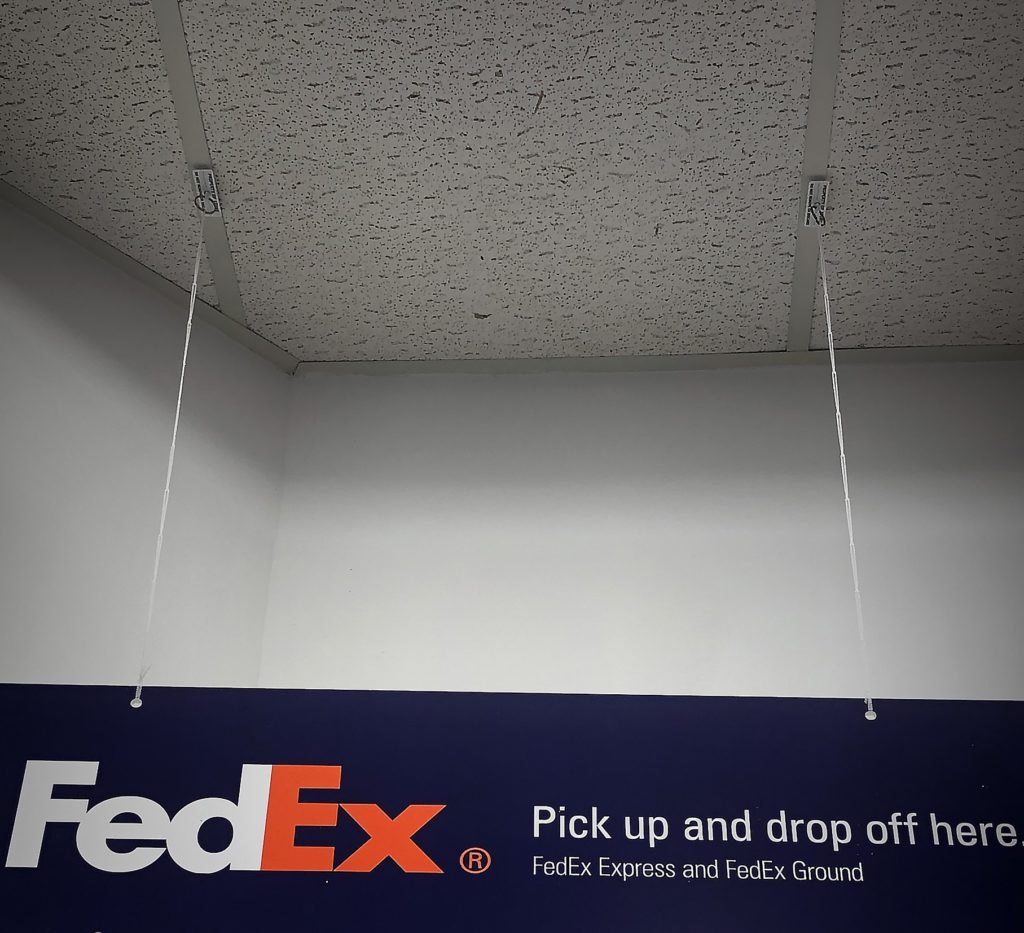The Ins and Outs of Hanging Sign Systems
Learn why ceiling signage offers vast landscape for retail messaging

When it comes to grabbing people’s attention in a grocery store, mall or retail setting, there aren’t many places left that haven’t already been covered with promotional materials.
“I like to say that the retail ceiling is the last frontier in the retail environment. Shelf edges and floors are packed,” says Thomas Stanley, Ceiling Outfitters. “You are inundated with information like that, so there is no place to put information but up.”

Grocery and other retail stores, such as sporting goods and clothing stores, usually display product information on floor banner stands and at the wall level on display cases, end caps and shelf edges in a flush or flag position. Meanwhile, they hang aisle markers and advertising, promotional, point-of-purchase, wayfinding, holiday décor and other signage from the ceiling, which is not as crowded as the lower levels and serves as the next best place to get noticed, Stanley says.
“It’s up high because that’s where people are looking,” Stanley says. “When they walk in they’re looking for directions and information, and they look up high. Down low is a very specific and focused message about particular products.”
Suspended signs as a store guide
Suspended signs, which have been around for decades, are a way to let customers know about a store’s different offerings from one vantage point and typically can be seen from across the store, says Charlie Capps, Sign Bracket Store.
“With suspended signage, you can attract customers to all areas of your establishment, revealing what they can’t see from the front of the store,” Capps says.
The signs shouldn’t be placed solely in front of the store to entice customers, but in well-organized displays throughout the store in a way that gets customers to shop the entire area, Capps says.
“Suspended signage that highlights key classifications is a must, and signage must be displayed in a manner that beckons customers to take a gander,” Capps says. “Less is more here-suspended signage should reveal an overall assortment, not all of the different styles.”
Capps gives the example of retailers selling window boxes and the other items typically sold alongside them, such as liners, hardware, soil, flowers, artificial plants and watering systems. A sign that reads “Flower Boxes” would be sufficient, whereas seven suspended signs for each individual category would be too much, he says. He also recommends avoiding placing signs that block other signs.
Suspended signs can be used to draw attention to specific products when placed above the items for sale, Stanley says.
“Suspended signs support the retailer’s overall marketing goal and enhance the in-store message using well-designed graphics, including good use of color, to catch the shopper’s attention and present the message,” Stanley says. “Ceiling signs should help develop the path to purchase, focus on engaging the buyer and have a single strong, clear message.”
Suspended signs, as well as floor and wall signs, typically are placed in high-traffic areas, including the main walkways in a mall setting and the perimeter aisles connecting a store’s departments, such as the produce, dairy, deli and pharmacy in a grocery store. Other high-traffic areas include raceways where hot deals are displayed and the center of the store with access to the main aisles and checkout counters; signs are placed either before customers checkout or on the other side after they’re done shopping.
“The main traffic areas for hanging signs are at the point of purchase, whether it’s paired with the product itself or at the checkout counter,” says Marc Tacke, VKF Renzel USA Corp. in Crown Point, Indiana. “Suspended signs work well because they can be placed at the customer’s eye line or above it. A hanging sign draws attention because it stands out from the background.”
Varieties & installation process for suspended signs
Ceiling and hanging signs come in multiple varieties, such as poster rails, banner rods, snap frames and clear plastic sign holders, Tacke says.
“They can be hung from hooks, attached to rails, hooked over wires and more, depending on the product,” Tacke says.

Typical hanging sign hardware includes aluminum rails or frames and acrylic or polyvinyl chloride, or PVC, pockets for inserting the poster or sign, Tacke says.
Signage can be hung from something simple like a fishing line to something more professional, such as iron designs that hold different shaped substrates, banner-type brackets that can be placed on pillars and flush-mounted brackets that can be used at the back of stores, Capps says.
“Consider bracketry for the ceiling that has ‘swinging sign’ capabilities, where one would permanently install the bracket but could change out the signs as seasons or trends change,” Capps says. “Banner-style brackets can be placed strategically in the store to get attention. And since these are located indoors, light-duty versions can be used, which are economical. For the back walls of a store, colorful merchandise incorporated with suspended signage will get traffic back there.”
Ceiling signs are installed in multiple ways, some safely and some proven to be riskier, and for this reason often are overlooked as a marketing and promotional option. The signs are installed on the three main types of ceilings found in commercial spaces, drop (which have metal strips), open-beam, and finished.
Traditionally, the signs are hung using a ladder or by renting (or owning) a scissor lift, Stanley says. The use of a ladder requires a minimum of three people for a safe installation, one person to climb and attach the signs to the ceiling, one to hold the ladder, and the third to hand up the sign to the installer. The signs are hung using connectors, which include metal-barb-tipped line, which typically can hold up to three pounds and is designed so that the barb guides the string through the sign hole for tie-off, as well as monofilament, clips, cables, hooks and jack chains.
“Traditional ceiling connectors are large and unsightly, and others when used on a drop ceiling twist on and off and chew up the edge of the drop ceiling panel,” Stanley says.
Stanley also has seen thumbtacks and paperclips stuck into drop ceiling panels to serve as connectors, he says.
Sign hanging system options
To avoid all of this, Ceiling Outfitters offers a product that allows installations and removals to occur from the floor. The Clik-Clik Magnetic Sign Hanging system consists of 18- and 23-foot installation poles, MagMovers to transport magnets called ClikMagnets to the ceiling and a LoopLine cord using a looping motion instead of a knot to connect the sign to the magnets for an even hang. The installation is quicker than traditional methods and only requires one installer, plus the LoopLine makes the connection stronger and safer, Stanley says.
“Our magnets don’t have to touch the panels, they just have to touch the T-Bars-that’s the magnetic portion we attach the magnets to,” Stanley says. “Our magnets are permanent, don’t fail and work well on a variety of ceilings.”
Ceiling Outfitters also offers traditional products, such as twist-on clips with string wrapped around them, but heavily promotes the Clik-Clik system, Stanley says.

“It’s a different way to hang signs that’s catching fire and being widely accepted in the marketplace,” Stanley says.
The ClikMagnets come in various magnetic pulls of 3, 5, 10 and 20 pounds, selected based on the size and weight of the sign. Substrates for the signs range from paper to plastic, including foam board, styrene, vinyl and corrugated plastic, but also can be made of heavier or thicker materials, such as plywood or PVC. Signs like aisle markers typically use the heavier materials and are more permanent than point-of-purchase signs, which are lighter and used on a temporary basis for a sale or other advertising.
“Signage on PVC or wood is a more permanent style sign, which should be used for basic commodities or classifications that your product assortments will always have,” Capps says. “If your store will always sell denim jeans, a ‘Men’s Denim’ sign may be worth the price to have a nice permanent sign made from PVC or aluminum. But a trendy sign for goods that are popular at the moment, a sign made from Coroplast may be just what is needed.”
For heavier signs, Ceiling Outfitters recommends using steel cable and the UrbanTrapeze, an adjustable, self-locking wire gripper for the connecting point.
Fabric is another option for a sign substrate, but is used more for trade shows and exhibitions, Stanley says.
“In retail, they are being used to highlight areas or segregate departments with color,” Stanley says. “Typically, they are for long-term use, while the other substrates … are for short-term, temporary use.”
Size & number of signs
The size of the ceiling sign depends on the space available and the distance from the floor to the ceiling. A typical size for P.O.P. signage is 24- by 36-inches, installed either as a landscape or portrait. A larger banner might be used for a specific themed event like a grand opening.
“Bigger is not always better. … Signage should relate to the size of your establishment, as well as to how important the offerings are in your assortment,” Capps says. “Key products to your seasonal offerings need a thoughtful-sized sign, while lesser categories don’t need as much emphasis. Keep your priorities straight and highlight what is most important.”
Deciding on the number of signs to put on the ceiling is another consideration and an aesthetic decision.
“I never advocate putting up a lot of signs,” Stanley says. “You want them to be able to look up and see what’s going on. You don’t just want to overwhelm them with messages from the ceiling and perimeters.”
Another option is combining several hanging signs with each other so that they appear to be a blended presentation, Stanley says.
“That way each can be smaller, but as a whole, they are large. Several large retailers are successfully doing this,” Stanley says.
Capps advocates no matter what is selected, retailers should routinely change ceiling signs to retain customer interest.
“Change is important in retail, and signs need to be swapped out to keep up with the shifts in customer tastes and what is in fashion,” Capps says.